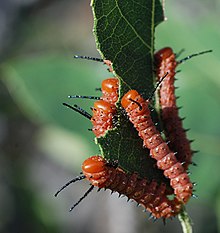Anisota
| Anisota | ||||||||||
|---|---|---|---|---|---|---|---|---|---|---|

Anisota stigma , male |
||||||||||
| Systematics | ||||||||||
|
||||||||||
| Scientific name | ||||||||||
| Anisota | ||||||||||
| Huebner , 1820 |


Anisota is a genus of butterflies from the family of the peacock moth (Saturniidae). The species are very similar to each other, which is why it is unclear which species status is justified. A distinction is made between 8 and 11 species, depending on the taxonomic approach. The genus is best known for its caterpillars, which live socially and can cause damage when crowded.
features
The largely similar small to medium-sized moths are brownish in color. Together with Dryocampa rubicunda , the genus is one of the smallest peacock moths found in the United States of America. The moths have a characteristic white discal spot on the forewings. There is a clear sexual dimorphism between the two sexes . The males imitate hymenoptera in their appearance ( mimicry ). In several species, they have transparent areas on the forewings that make them look like bees. The males have double-feathered antennae . The much larger females lack the hyaline areas on the wings. The male genitals are broad and quite similar in all species. Only in Anisota virginiensis is the aedeagus long and curved.
In several species, the caterpillars are colored in warning colors. It is believed that this and the tannins ingested with the leaves of the food plants deter predators. In all species, with the exception of Anisota finlaysoni , the caterpillars have a conspicuous pair of horns on the second thoracic segment . This characteristic also occurs in the genus Dryocampa . In the last stage of caterpillars one can determine the sex of the animals based on the size, since the females are significantly larger.
Occurrence
The genus is mainly found in the southeastern United States of America. Only a few species are found further west as far as Mexico.
Way of life
The males are diurnal. They fly very quickly, which, apart from their appearance, gives them even more resemblance to bees. The females are usually nocturnal, but oviposition can begin in the late afternoon. They lay their yellow to orange eggs in groups of 15 to 150 on oaks ( Quercus ) and occasionally on chestnuts ( Castanea ) and hazelnuts ( Corylus ). You can see the caterpillars through the transparent eggshell. The caterpillars initially live in large groups and are therefore very noticeable. Sometimes they still live gregariously even in later stages. Many species are abundant, which can occasionally cause damage. Pupation takes place in a loosely built chamber in the ground. The pupa hibernates there .
Taxonomy and systematics
The genus was first described by Jacob Hübner in 1820. The type species is Bombyx stigma Fabricius, 1775. The relationships between the species within the genus have been examined several times. An approach by Riotte & Peigler (1980) differentiates 11 species on the basis of morphological characteristics of caterpillars and adults , whereby the differences between some species are only minimal and a distinction therefore remains doubtful. It is assumed that some of these are subspecies. Tuskes & Collins therefore try to differentiate the species based on their different pheromones . They assign the species status to eight species:
- Anisota stigma (Fabricius, 1775)
- Anisota manitobensis McDunnough, 1921
- Anisota consularis Dyar, 1896
- Anisota senatoria (Abbot & Smith, 1797)
- Anisota finlaysoni Riotte, 1969
- Anisota oslari Rothschild, 1907
- Anisota virginiensis (Drury, 1773)
- Anisota peigleri Riotte, 1975
The Natural History Museum's Global Lepidoptera Names Index lists the following additional species in the genus:
- Anisota assimilis (Druce, 1886)
- Anisota dissimilis (Boisduval, 1872)
- Anisota leucostygma (Boisduval, 1872)
supporting documents
Individual evidence
- ↑ a b c d e f P. M. Tuskes, JP Tuttle, MM Collins: The Wild Silkmoths of North America. A Natural History of the Saturniidae of the United States and Canada . Ed .: George C. Eickwort. 1st edition. Cornell University Press, Ithaca / London 1996, ISBN 0-8014-3130-1 , pp. 69 f . (English).
- ↑ The Global Lepidoptera Names Index - Anisota ( page no longer available , search in web archives ) Info: The link was automatically marked as defective. Please check the link according to the instructions and then remove this notice.
literature
- PM Tuskes, JP Tuttle, MM Collins: The Wild Silkmoths of North America. A Natural History of the Saturniidae of the United States and Canada . Ed .: George C. Eickwort. 1st edition. Cornell University Press, Ithaca / London 1996, ISBN 0-8014-3130-1 (English).
Web links
- Lepidoptera and some other lifeforms (English)
